Episodes

Wednesday May 04, 2022
Wednesday May 04, 2022
How do you attract the perfect interior design client? How do you decide what type of client will be the best fit? After 30 years in high-end commercial and residential design, Pamela Durkin now helps other designers create a business they love by teaching them how to attract their ideal clients. In this episode of the Wingnut Social podcast, she shares how to design your perfect client, how to leverage your network for referrals, and how to “shock and awe” potential clients so they become actual clients.
What You’ll Hear On This Episode of Wingnut Social
[2:07] Wingnut Webinars and Wingnut Academy Updates
[4:10] Mini News Sesh: NEW Instagram features being released
[9:11] Learn more about Pamela Durkin
[12:35] How to find your perfect client
[17:11] Pamela’s tips for new interior designers
[21:23] How niching down impacts your bottom line
[27:58] How to leverage your network
[30:26] Pamela’s process of auditioning clients
[35:10] Pamela’s “Shock and Awe” box
[41:41] The What Up Wingnut Round!
[45:05] How to connect with Pamela Durkin
[50:42] Blooper Reel!
Connect with Pamela Durkin
Pamela’s website
Connect with Pamela on Instagram
Read Pamela’s book: Elevate!
Resources & People Mentioned
Wingnut Webinars
Get Wingnut Academy Updates
Follow us on Instagram and you just might win a scholarship to our Instagram for Designers courses!
Get FREE shipping on your first order from Article
The Big Leap by Gay Hendricks
Sell the Way You Buy by David Priemer
How to narrow down your perfect client
Designers are scared to leave money on the table, so many don’t narrow down their focus and choose a niche for their design business. But you need to. Pamela shares that you should start the process by taking the best things about past clients that you’ve worked with and molding them into a persona.
What motivations did they have? What was their personality like?
What work have you done that’s been profitable?
How much do you enjoy doing that type of project?
These things create a goal for the type of client you’re trying to attract. Pamela is from NJ and realized that when she did her best work, it was with people who made decisions quickly. Executives are the best types of clients for her. They make thousands of decisions every day, they make them quickly, and they hire professionals. They appreciated her personality and they were on the same page. Knowing this allowed Pamela to create connections quickly. You want people to say, “I feel like I know you.”
What do you do if you’re new to the business? How do you choose considerate people to work with? How does narrowing your focus impact your bottom line? Listen to learn more!
Pamela’s process: auditioning clients
It may sound odd at first glance—but it’s genius. Pamela auditions her clients. She starts by having a 15-minute phone conversation with them (nine out of ten times it’s a referral). She asks them to tell her about the project. The goal is to get a feel for their personality and their style—not their budget.
Why does that matter so much? Because interior designers are in the most intimate parts of people’s homes. They need to build rapport and foster open communication. Pamela will turn down a job if she doesn’t think it will be a good fit. Most people appreciate that.
Pamela will also ask for the project address and look at photos of the home to talk more intelligently about what they want to do. This will also help her gauge the value of the property and if it’s within her scope of work. If everything lines up, Pamela will schedule an in-person meeting. Her next step is genius.
Pamela’s “Shock and Awe” box
Before the meeting, she sends potential clients a “Shock and awe” box. The box will include a gift, a drink and snack, and a handwritten note that says, “Enjoy this snack while learning more about us.” She’ll include a few back issues of her monthly newsletter so they can get to know her. She shares her professional profile, an FAQ sheet, her project process, and more.
The key is to send this before they’ve hired her. Not only does it make an impact, but the box shows how organized you are, shows how you’re going to take care of them, and shares your communication style. You have to remember that people are buying the experience. Once you get to the in-person meeting, they’ve learned so much about you that they only ask questions about the things they actually have questions about. It leads to a more productive and intimate conversation.
Connect With Darla & Wingnut Social
www.WingnutSocial.com
On Facebook
On Twitter: @WingnutSocial
On Instagram: @WingnutSocial
Darla’s Interior Design Website
Check out the Wingnut Social Media Lab Facebook Group!
786-206-4331 (connect with us for your social media marketing needs)
Subscribe to The Wingnut Social Podcast on iTunes, YouTube, or TuneIn
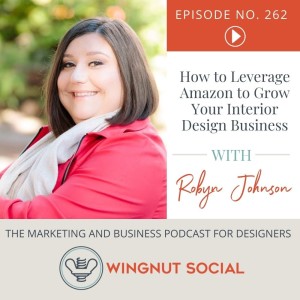
Wednesday Apr 27, 2022
Wednesday Apr 27, 2022
10 years ago, Robyn was a youth minister who couldn’t make ends meet. So she took $100 and started buying things at garage sales and reselling them on Craigslist, eBay, and Amazon.
In three years, she turned that $100 into a million-dollar business: Marketplace Blueprint. Robyn started an agency six years ago to help businesses—everything from companies that are pre-launch to publicly-traded companies—be successful on Amazon.
Robyn is now one of the foremost leaders on the topic of selling products on Amazon. Her business specializes in listing optimization and advertising on Amazon. Robyn Johnson is nothing short of brilliant. In this episode of Wingnut Social, She shares some of her top tips and tricks to get visibility on Amazon.
What You’ll Hear On This Episode of Wingnut Social
[1:38] Wingnut Academy is launching SOON!
[3:06] Mini News Sesh: Instagram’s “link in bio” tool
[7:05] Learn more about Robyn Johnson
[9:52] How an Amazon storefront benefits interior designers
[12:38] What should an interior designer publish?
[19:20] How to become a #1 Best-Seller on Amazon
[25:46] The basics of SEO on Amazon
[26:54] When you should launch an Amazon shop
[33:14] Create a store or be an affiliate marketer?
[34:26] How to set up an Amazon storefront
[37:36] The What Up Wingnut Round!
[39:21] How to connect with Robyn Johnson
[43:39] Blooper Reel!
Connect with Robyn Johnson
Marketplace Blueprint
Connect on LinkedIn
Follow on Twitter
Robyn’s Podcast
Resources & People Mentioned
Get FREE shipping on your first order from Article
Sign up for Wingnut Academy updates!
Check out Episode #258 with Julianne Hendrickson
Sign up for the next Wingnut Webinar
Writers Access
How to Become an Amazon Seller
Amazon Seller University
Amazon Kindle Direct Publishing
The 14 Guiding Principles of Amazon
Walt Disney: The Triumph of the American Imagination
Get Robyn’s 20 page listing optimization guide for Amazon
Get a FREE mini-audit of your listing
How an Amazon storefront benefits interior designers
The first thing you can do is self-publish a book on Amazon. Why does it matter? Because writing a book can catapult your career forward. Being a published author can help you get speaking engagements. It lends you credibility and brings in warm leads.
Robyn says you can’t short-change the power of Kindle. When Robyn published her first book, she printed books to give to people at a conference because they may throw away a business card but they won’t throw away a book. It was memorable and helped solidify her as an authority figure in the space.
Secondly, you can create and sell your own branded products in an Amazon store. If you use the same piece repeatedly in your designs, you can contact the brand and see if they’ll let you sell a white-label version as part of your personal brand. Many companies are open to this.
If you’re looking for a brand that’s trying to find influencers, look for those that are active on Amazon. Many are embarrassed and afraid to seek out influencers. The worst they can say is no—but they’ll often say yes.
When should you launch an Amazon shop?
You can list as little as one item on Amazon. But Robyn notes that you need to aim to sell 40 items per month to break even on the $40 monthly fee it costs to be a professional seller. Amazon takes anywhere from 8–20% of the total cost of the product. If Amazon ships the item for you, you’ll pay storage fees as well as shipping fees based on the size and weight of the product (but likely still cheaper than shipping the product yourself). It can help you lower overall costs and increase your margins.
Any product you buy legitimately can be sold on Amazon. As long as the good is authentic, you’re welcome to sell it at any price you want. But take note—if Amazon feels the price is too high, they’ll make it more difficult for customers to buy.
Robyn points out that you will get better margins selling on your own website. However, if you have a high-demand product that people are looking for, keep in mind that some people will only shop on Amazon. Amazon has a ready-made base of buyers. It can help you grow your brand because users have already built a level of trust with Amazon.
What could you sell that differentiates you or is irreplaceable? How do you become a seller on Amazon? Robyn shares the secret to becoming a #1 best-seller on Amazon listen to find out what it is!
Connect With Darla & Wingnut Social
www.WingnutSocial.com
On Facebook
On Twitter: @WingnutSocial
On Instagram: @WingnutSocial
Darla’s Interior Design Website
Check out the Wingnut Social Media Lab Facebook Group!
786-206-4331 (connect with us for your social media marketing needs)
Subscribe to The Wingnut Social Podcast on iTunes, YouTube, or TuneIn

Wednesday Apr 20, 2022
Wednesday Apr 20, 2022
What does it take to attract luxury design clients? HINT: It doesn’t require being pretentious. It has everything to do with offering irreplaceable value. What can you bring to a project that a client can’t find anywhere else? It’s about providing a luxury experience coupled with what’s uniquely you. In this episode of Wingnut Socal, Melissa Sacco shares what she offers to attract luxury design clients that no one else can. She’ll help you think through what makes you irreplaceable.
What You’ll Hear On This Episode of Wingnut Social
[4:43] Mini News Sesh: TikTok has stories!
[9:05] Learn all about Melissa Sacco
[11:41] Melissa’s business model
[18:37] How Melissa handles scope creep
[21:40] The key to attracting luxury design clients
[29:51] Specializing in high-end custom furniture
[33:36] What a discovery call with Melissa looks like
[35:05] Growing a business and delegating
[38:36] The What Up Wingnut Round!
[40:19] How to connect with Melissa Sacco
[44:29] Blooper Reel!
Connect with Melissa Sacco
Melissa Sacco Interiors
Follow Melissa on Instagram
Resources & People Mentioned
Get FREE Shipping on your first order from Article
Sign up for Wingnut Academy updates!
Check out the Google Ads webinar on April 26th at 11am
Rocket Fuel by Gino Wickman and Mark Winters
Working with luxury design clients
From the first meeting, Melissa educates her clients about the design process and what makes her uniquely qualified to tackle their projects. Sacco Interiors focus on creating an elegance that’s never pretentious. Everything in your home will be cohesive—full of texture, dimension, and detail.
When you offer high-end luxury design, you must always be ahead of the game. There are endless moving parts and decisions to be made. It involves working out details and kinks to get a clear vision of what you’re trying to achieve. Interior designers bring value by being knowledgeable in all of the trades. You provide scaled drawings, elevations, specification sheets, paint schedules, complete on-site visits, and much more.
Melissa gets to know her clients before she gets started with the design process. Her goal is for the client to be comfortable with her so she can nail their design. She’ll share images, ask deeper questions, and look at functionality—all with the goal to stay laser-focused throughout the project. Because once they start, they drive full force ahead. The only way that happens is if everyone is on the same page.
How Melissa attracts luxury design clients
Melissa believes to attract the right people, you have to share who you are. Melissa’s ideal client is someone who’s worked hard to get where they are. They are down-to-earth and genuine people—just like her. That’s why these clients want their homes to be comfortable. Most have demanding jobs. They want to come home, walk through their front door, and feel at ease.
So Melissa shares inspirational quotes. She gives potential clients a glimpse behind the scenes. Lastly, she focuses on just being herself. If she’s on a jobsite doing an install, she’s in sneakers and a sweatshirt. She’s on the floor opening boxes, putting things together, and getting her hands dirty. She does whatever it takes to ensure a client’s project is amazing in the end.
Don’t be fooled—high-end luxury clients are on social media. They’re people, just like anyone else. They’re professionals—doctors, lawyers, and CEOs of large companies. They talk. They network. They will share what you’ve done with other people.
Melissa’s irreplaceable customer furniture sets her apart
If you become one of Melissa’s clients, you will see custom built-ins and one-of-a-kind furniture pieces that no one else will have. Why? Because she designs them herself, each piece different from the last. No one will ever have the same chair or built-in. Melissa’s custom pieces have positively impacted her bottom line. It differentiates her from other high-end interior designers and works to continually attract her ideal client.
How did Melissa start offering custom furniture? What has she done to delegate tasks and projects as she’s grown her business? Listen to the whole episode to hear her process.
Connect With Darla & Wingnut Social
www.WingnutSocial.com
On Facebook
On Twitter: @WingnutSocial
On Instagram: @WingnutSocial
Darla’s Interior Design Website
Check out the Wingnut Social Media Lab Facebook Group!
786-206-4331 (connect with us for your social media marketing needs)
Subscribe to The Wingnut Social Podcast on iTunes, Google Podcasts, or TuneIn
Audio Production and Show notes byPODCAST FAST TRACKhttps://www.podcastfasttrack.com

Wednesday Apr 13, 2022
Wednesday Apr 13, 2022
John Dupra co-created Revel Woods, a platform that helps designers provide their clients with a luxury floor sourcing experience. Revel Woods elevates the traditional process so interior designers can offer a high-end service that can’t be replicated. In this episode of Wingnut Social, John shares how you can become a Revel Woods pro and become THE source for your client’s customer flooring (and maybe even create your own custom line of flooring).
What You’ll Hear On This Episode of Wingnut Social
[1:28] Webinar and Wingnut Academy Announcements
[4:12] Mini News Sesh: Instagram testing a new feed
[7:45] Learn more about John Dupra and Revel Woods
[12:53] The importance of offering a unique high-end experience
[21:17] Revel Wood’s training and certification program
[23:35] How to handle the relationship with your contractors
[27:22] How Revel Woods works with eCommerce partners
[30:27] Revel Woods is launching a NEW platform
[32:23] John’s take: The future of wood flooring
[42:40] The What Up Wingnut Round
[44:04] Where to learn more about Revel Woods
[47:10] Blooper Reel!
Connect with John Dupra
Revel Woods Fine Hardwood Flooring
Apply for Revel Woods Pro Account
Revel Woodson Instagram
Connect with John on LinkedIn
Resources & People Mentioned
Sign up for Wingnut Academy updates!
How Interior Designers Leave Money on the Table with John Dupra
Influence: The Psychology of Persuasion
The importance of offering a unique high-end experience
Sourcing floors typically includes taking clients to a flooring showroom they could have visited on their own. It’s been a necessary evil because there haven’t been options for designers to source trade options. Even trade-only showrooms offer brands available anywhere—unless you go truly custom and jump price levels. Most designers don’t need something that high-end.
John points out that you wouldn’t go to Bob’s discount furniture outlet to source furniture for a high-end client. Why would you do it for flooring? You don’t want to offer a service or experience they could’ve done on their own. Revel Woods is a platform that sources flooring for you. Some of it might be available elsewhere but they private label everything.
Create your own line of luxury hardwood flooring
Revel Woods is also developing a program with a manufacturer in Canada that will do a semi-custom made-to-order flooring. Flooring options are usually like the pizza aisle at the grocery store—you have premade cheese, pepperoni, supreme, etc. The program they’re developing is like a pizza shop where you choose your crust, sauce, cheese, and toppings.
You get to choose from 15 master colors, solid or engineered hardwood, and different widths, grades, lengths, and sheens. You can create your own collection exclusive to you and only available to your clients. They give you complete and total control over the process. John shares how pricing and wholesaling work, so keep listening.
Revel Woods is launching a NEW platform: Revel Woods Plus
Revel Woods is partnering with a major manufacturer to build a visualization platform. You can use sample rooms or take a photo of a client's room and swap the flooring out. It will be built into the Revel Woods platform with hundreds of private-label trade-only options only accessible to designers. You can use this tool to show a client what the flooring will look like in their room. You can also send them the link to the product (without pricing).
Fine hardwood flooring will never go out of style, but luxury vinyl planks have been the go-to flooring option of late. What does John think will be the next trend? His answer may shock and will certainly surprise you!
Connect With Darla & Wingnut Social
www.WingnutSocial.com
On Facebook
On Twitter: @WingnutSocial
On Instagram: @WingnutSocial
Darla’s Interior Design Website
Check out the Wingnut Social Media Lab Facebook Group!
786-206-4331 (connect with us for your social media marketing needs)
Subscribe to The Wingnut Social Podcast on iTunes, Google Podcasts, or TuneIn
Audio Production and Show notes byPODCAST FAST TRACKhttps://www.podcastfasttrack.com

Wednesday Apr 06, 2022
Wednesday Apr 06, 2022
Your interior design logo is a direct reflection of you and your brand. If you wanted to hire a photographer but the photos on their website were blurry or out of focus, you wouldn’t hire them, right? As an interior designer or architect, you are being judged on your branding more than many other professions.
Jason Byer—the Marketing and Partnerships Manager at Crowdspring—shares that strong brands attract more customers, justify premium price points, and build more resilient businesses. Your logo is an important part of your brand identity—is it up to snuff? Find out in this episode of Wingnut Social.
What You’ll Hear On This Episode of Wingnut Social
[0:58] Wingnut Webinar and Wingnut Academy announcements
[3:04] Mini News Sesh: Moderator Feature for Instagram Live
[6:07] Learn more about Jason Byer
[8:28] How branding mistakes can negatively impact sales
[10:38] The difference between brand and brand identity
[13:31] The importance of your interior design logo
[24:07] How to properly complete a brand refresh
[32:10] The What Up Wingnut! Round
[33:56] How to connect with Jason Byer and Crowdspring
[37:23] Blooper Reel!
Connect with Jason Byer
Crowdspring
Follow Jason on Twitter
Connect with Jason on LinkedIn
Resources & People Mentioned
Check out the Google Ads webinar on April 26th at 11am
Get updates on Wingnut Academy
Why We Sleep: Unlocking the Power of Sleep and Dreams
The difference between brand and brand identity for interior designers
Branding is a loosely used term that people often associate with logos. But branding is every interaction that a customer has with your company, your product, and your service. We know what certain brands deliver, right? Amazon customer service is top-notch. With companies like Starbucks or McDonalds, anywhere you go, you know the product will be consistent.
It’s not the same for architects and interior designers. There are many unknowns about your brand, your service, your price point, and your success. But a potential client does know you’re trying to sell them something. So you have to think about every touchpoint someone has with you. Your brand is being shaped whether you take an active role or not.
Your brand identity is everything that people see—logos, backgrounds, and filters on social media, image choices on your website, etc. Your brand identity should be informed by your brand. Because it conveys who you are, an interior designer's logo needs to be spot-on.
A carefully crafted logo is key to consistent marketing of your design business
The human brain can process images 1,000x faster than text. Many people poorly communicate what they do and who they serve. But a logo communicates that immediately. But what makes your interior design logo shine?
Start with choosing the right color. You can easily Google the meanings of colors. The colors you choose are dictated by your brand and audience. If you want to create trust, you use the color blue. That’s why banks and financial advisors use blue. If you are serving the environment or want to create more profit you might use the color green. Red is used to make people pay attention. You want to think about how colors interact with your brand.
Shape, style, and negative space are other aspects to consider. How do you play with different elements in your design? Will you use hard or soft angles? Are you trying to communicate strength and stability—or a closer connection with clients?
The actual logo icon can be a wordmark: the name of your business stylized in a unique and custom way. You can pair an icon with your wordmark that allows you to scale it. Why? Because a wordmark doesn’t usually fit well within a square. Logos have to be able to scale if you want them to look professional. A symbol paired with your wordmark works well in this.
How to create an interior design logo that conveys your brand identity
All of these things communicate your brand, So where do you start? With a creative brief. A good designer will ask:
Who are your competitors?
Who is your audience?
What do you want them to know?
How are you differentiated?
Is trust more important than stability or growth?
After answering these questions, you’d look at color, shapes, and icons that communicate your message. When you package that together, someone should intuitively understand who your audience is within fractions of a second. That’s what a visual brand identity should do.
If red is your color, you could make it your schtick—but it may not resonate with how everyone else views the color red. Red signifies danger, it makes you stop. It’s important to leave your preferences at the door and think about your market. What will trigger the right emotion in your customers?
Jason emphasizes that “Your logo is there to create an emotion. And it’s there to create intrigue. And it’s there to create consistency across all of your marketing.”
How do you properly complete a brand refresh? Why should you hire a graphic designer instead of trying to create your logo yourself? Why should you avoid a logo generator at all costs? Jason answers all of your need-to-know questions about creating an interior design logo in this episode of Wingnut Social.
Connect With Darla & Wingnut Social
www.WingnutSocial.com
On Facebook
On Twitter: @WingnutSocial
On Instagram: @WingnutSocial
Darla’s Interior Design Website
Check out the Wingnut Social Media Lab Facebook Group!
786-206-4331 (connect with us for your social media marketing needs)
Subscribe to The Wingnut Social Podcast on iTunes, Google Podcasts, or TuneIn
Audio Production and Show notes byPODCAST FAST TRACKhttps://www.podcastfasttrack.com

Wednesday Mar 30, 2022
Wednesday Mar 30, 2022
Hendrickson Interiors was born in 2016 when a friend asked Julianne to help design a new build. Julianne had no idea what she was doing but loved picking out pretty things. The builder loved her designs and hired Julianne to work together on more homes. Before she knew it, she had more clients than she knew what to do with.
Julianne had no business plan, no idea how to open an account with a furniture firm, and she was still teaching. After burning the candle at both ends for two years, Julianne decided to dive full-time into interior design. Since then, she’s grown from being a solopreneur to a team of six—a full-service custom interior design firm serving clients throughout Tampa Bay. She shares how she grew her team and learned to delegate in this episode of Wingnut Social!
What You’ll Hear On This Episode of Wingnut Social
[1:16] Check out our FREE webinars!
[2:55] Mini News Sesh: Updated Creator Tags
[6:10] Learn more about Julianne’s journey
[10:16] Julianne’s philosophy on delegating and hiring
[16:07] How to find a sweet spot with your waitlist
[19:20] Why Julianne hired a business coach
[21:36] Marketing before & After Wingnut Social
[25:56] What’s next for Hendrickson Interiors?
[28:34] Julianne’s strict budget
[30:51] The What Up Wingnut Round!
[32:29] How to learn more about Hendrickson Interiors
Connect with Julianne Hendrickson
Hendrickson Interiors
Find Hendrickson Interiors on Instagram
Resources & People Mentioned
Check out our FREE webinars!
Sign up for Wingnut Social Academy notifications
The Fred Factor by Mark Sanborn
Dakota Design Co.
Delegation is the key to scaling your business
Julianne admits that she’s a control freak by nature. She likes to do things her way. But she learned that someone else could do things just as well as her, even if their choices are slightly different. When Julianne released control, they were able to get more work done. As the process became smoother, she decided to keep hiring and making more people happy.
Julianne realized that you can delegate many different ways—it doesn’t have to be all or nothing. You can delegate someone to complete a task to be reviewed together. You can delegate through the design phase and review things together. Or you can delegate the design phase and review pricing together. Realizing this was eye-opening for Julianne. A good delegator knows how much someone is capable of. If you let someone do their job—without micro-managing them—it empowers them.
Building a time and hiring a business coach
Julianne’s first large client gave her $50,000 to work with and she went straight to a bookkeeper and said, “Oh my God—what do I do with this?” She didn’t have any business accounts or QuickBooks. Her bookkeeper took the reins and has been with her ever since. Julianne also hired an operations manager (who handles the warehouse), a project coordinator, and someone who handles accessory purchasing full-time. Her most recent hire was a part-time team member to handle purchasing and tracking orders. Once Julianne had these people in place, she pulled herself out of the weeds. Then she hired a business coach.
As a business owner, it’s easy to get enmeshed in the day-to-day of the business. Julianne’s business coach, Katie, has helped her gain a top-level view of her business. Katie helped Julianne walk through their design process from beginning to end. She pointed out missing pieces, helped her reformat things, and wrote every single thing Julianne gives a client. She has templates for everything—delayed items, trade days, apology letters, and more. It keeps the entire team on the same page, which is what elite clients want. It’s also important to scale and grow a team. A business coach can help unify your team and improve your efficiency.
How to find a sweet spot with your waitlist
Hendrickson Interiors is operating on a waitlist of six months or longer. When Julianne gets information from an inquiry, she’ll know if the potential client is a good fit immediately. Julianne is honest with people and lets them know if they’ll be on her waitlist. The clients that are worth it will wait. If they can’t wait, they’ll shop around until they can find someone that will do it the fastest—but it may not be the best quality. Julianne isn’t worried about turning down work because she knows the right people are already waiting for her.
How has Julianne’s interior design business grown since working with Wingnut Social? How does operating on a strict budget help her continue her upward trajectory? She shares more about her uber-successful design firm in this episode!
Connect With Darla & Wingnut Social
www.WingnutSocial.com
On Facebook
On Twitter: @WingnutSocial
On Instagram: @WingnutSocial
Darla’s Interior Design Website
Check out the Wingnut Social Media Lab Facebook Group!
786-206-4331 (connect with us for your social media marketing needs)
Subscribe to The Wingnut Social Podcast on iTunes, Google Podcasts, or TuneIn
Audio Production and Show notes byPODCAST FAST TRACKhttps://www.podcastfasttrack.com
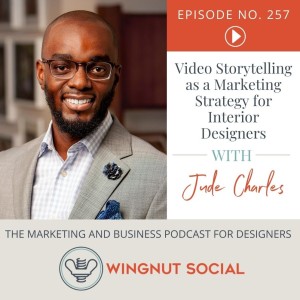
Wednesday Mar 23, 2022
Wednesday Mar 23, 2022
When Jude Charles was 17, he took a video production class. At the end of the year, Jude’s teacher handed him a yellow envelope and told him that he had to start a business. Inside was his first set of business cards. Since then, Jude has dedicated his life to helping purpose-driven entrepreneurs tell their stories. He firmly believes that “Stories aren’t just how we connect as people and human beings but story is what differentiates you from someone else.”
In this episode of Wingnut Social, Jude emphasizes that you have to start sharing your story. Video storytelling breaks through the noise and sets you apart. Jude shares how to overcome the intimidation factor, what type of stories to tell, and shares the best way to structure your story. Don’t miss it!
What You’ll Hear On This Episode of Wingnut Social
[0:58] Check out our FREE webinar with Stacey Martin
[2:56] Mini News Sesh: Instagram’s Visual Discovery Tool
[7:14] Learn more about videographer Jude Charles
[11:19] Overcoming the intimidation of video
[15:30] Dramatic demonstration of proof
[20:24] The importance of relatability in video content
[24:04] Why you should just hit the record button
[29:26] Jude’s videography tips for YouTube
[31:54] Make testimonials part of your contract
[36:12] The What Up Wingnut Round!
[38:58] How to connect with Jude Charles
[42:07] Blooper reel!
Connect with Jude Charles
Head on over to Jude’s Website
Sign up for Jude’s Newsletter
Connect with Jude on LinkedIn
Resources & People Mentioned
Sign up for Updates for Wingnut Academy
March 24th at 11 am: Stacey Martin Webinar
Hot Seat by Jeff Immelt
Not Fade Away by Peter Barton
Overcoming the intimidation of video
Jude points out that everyone has three different stories that can be shared at any point. These stories are important to use every day on social media. You can repeat them over and over again. What are they?
Your origin story: How you got into the business you're in.
A transformational story: Testimonials, case studies, before & afters, etc. What does life look like after?
Why you’re doing the work you’re doing: Why should someone choose you over anyone else?
But how do you get started? Jude has been a guest on over 70 podcasts. He’s studied storytelling for over 20 years. He still listens to himself tell his story so he can find new ways to tell it. It also helps him learn how to connect better with an audience. If you rehearse your story and practice recording it, it makes it less intimidating.
Jude’s video storytelling method: dramatic demonstration of proof
You can’t just sit in front of a camera and tell your story. That’s boring, right? The way that you make your story interesting is by using the five different types of demonstrations:
Behind the scenes: What happens as you’re sourcing materials? What does the design process look like? What is going on that people don’t usually get to see?
Live illustration: How do you illustrate a point someone may not understand? Jude worked with someone who said, “Construction is like a puzzle.” So they got a large puzzle—of a project they had completed—and had the team put a puzzle together.
Social proof: This is testimonials, case studies, before and afters, etc.
Transformation: These are before and afters—how someone’s life is transformed after a change has been made.
Unique mechanism: What makes you unique that someone else can’t copy? How can you demonstrate that on camera?
Storytelling is about a specific moment in time. These moments have led you to where you are today. They influence how you’ve become a great designer. Jude points out many people believe that their story isn’t unique or interesting—that no one will care. But what debunks the idea that no one cares? Telling your story. You’ll realize that there will be someone it resonates with.
Jude believes so strongly in the power of video storytelling that he only takes on five video production clients a year. Why? Because he works to understand who they are on a deep level. It takes time to be able to get to know someone and accurately portray the essence of who they are with video storytelling.
Why you should just hit the record button
Record yourself telling a story. Record yourself telling the story that you take for granted. Jude emphasizes that you shouldn’t sell yourself short—or overthink it. Your clients aren’t aware of everything you do to get a project completed. You want to create content so people understand what you do and can appreciate the value that you create. What you do will be different from the next interior designer. So where do you start?
Just document what you’re doing every day to get in the habit of creating content. You don’t need fancy equipment to get started because every smartphone is equipped with a great camera. You don’t even have to share it on social media. If you share a video of your process with a potential client, it makes them trust you more. It’s not only social proof but it’s a sales tool. You’ve made them part of the journey. Hearing something said 1,000 times is not as powerful as seeing it once.
Listen to the whole episode to hear Jude’s video storytelling tips for content on different social media platforms, including YouTube.
Connect With Darla & Wingnut Social
www.WingnutSocial.com
On Facebook
On Twitter: @WingnutSocial
On Instagram: @WingnutSocial
Darla’s Interior Design Website
Check out the Wingnut Social Media Lab Facebook Group!
786-206-4331 (connect with us for your social media marketing needs)
Subscribe to The Wingnut Social Podcast on iTunes, Google Podcasts, or TuneIn
Audio Production and Show notes byPODCAST FAST TRACKhttps://www.podcastfasttrack.com

Wednesday Mar 16, 2022
Wednesday Mar 16, 2022
What is a Google ad? How can you leverage Google ads to drive leads to your interior design business? How do you stand out against your competition? In this solo episode of Wingnut Social, Darla dives into the need-to-know basics of Google ads. It’s a great strategy—in conjunction with SEO—to drive traffic to your website and help you build your business.
What You’ll Hear On This Episode of Wingnut Social
[2:02] March 24th at 11 am: Stacey Martin Webinar
[3:07] Mini News Sesh: The Career Gap feature on LinkedIn
[5:47] Your marketing strategy: Google ads and SEO
[8:17] Tip #1: Control what your audience sees with ad extensions
[15:16] Tip #2: Leverage keywords in Google ads
[17:08] Tip #3: Create a high-quality ad
[20:40] TIp #4: Be specific
[25:01] Blooper Reel!
Resources & People Mentioned
March 24th at 11 am: Stacey Martin Webinar
Episode #250 with Stacey Martin
A good marketing strategy should leverage Google ads and SEO
When you search on Google, the first four or five results say “ad” in the top left corner. Usually, you’ll see results related to the topic you searched for. Advertisers pay to get their ads on the page for that search.
Google ads are a great way to cut in line and get on the first page of Google and it’s a whole lot faster than SEO. SEO is still heavily important. You want the right keywords placed in particular places on your website. Why? So when someone searches for “Interior Designer Philadelphia” your business is in the top 10 search results.
But proper SEO is a time-consuming process. It’s a long game, not a quick win. You have to invest a lot of time and often money to begin to see traction (sometimes it takes over a year). It’s a necessary evil—you have to do it—but Google ads are a great way to gain some traffic to your site now.
If your ad is structured properly, for the right amount of money, you can show up on the top of the first page. So when someone searches for “Susan McNuggets Interior Designer” they’ll find you. Even if your SEO is on par and you’re #1 in the search results, ads will still be placed above your business. That’s why ads are a great way to beat out the competition.
Tip #1: Control what your audience sees with ad extensions
At the top of the search results, you’ll see your headline. Underneath that, you’ll see categories that are called site extensions (i.e. for “Wingnut Social” you’ll see “podcast,” “social media marketing agency,” etc.). Google is searching the organic copy of your website and making the site extensions how they see fit.
But when you place an ad, you can dictate what the ad extensions will be. If I placed an ad for Wingnut Social, I don’t want “What’s happening” showing up on my ad. I want searchers to see how we can help them. I want to draw them to the website. You need to make sure whoever is creating your ad uses the proper extensions.
There are different types of extensions:
Phone numbers: This will show the phone number plainly in the ad
Location: This is super important if you’re relying on local traffic to find your design firm
Image: When your ad shows up you see the square image to the right (too many people don’t use this!)
Leveraging the ad extensions helps you get more qualified leads because someone is getting the information they need at first glance. If your ad is eye-catching and people click on it, Google will deem your ad more relevant. If that happens, sometimes Google will place your ad higher—even if you’re paying less.
Tip #2: Leverage keywords in Google ads
What keywords are people typing in the search bar that YOU want to be discovered for? These words NEED to be used in your ad. You can leave out flowery phrases like “The most luxurious designer” and focus on “Interior Designer Miami.” Keep the keywords in your ad straightforward. Secondly, make sure you use the keyword(s) in your title and description.
How do you find keywords? Google has a handy keyword planner you can use to look up keywords and see how many people are searching for a keyword. If the search volume is too low, Google won’t bother showing it.
Tip #3: Create a high-quality ad
Where you rank on the results page can be bid on. You can outbid a higher-quality ad if you shell out more money. But it’s better to create a high-quality ad and pay less, right? Google looks at your quality score to determine how much you have to pay for your ad and how often they’ll show it.
A higher quality score will pay less for clicks because it enhances the user experience. Google wants people to get the results they’re searching for. It must be relevant. If that means showing your ad at $10 because the experience is better, it’s taken into consideration. If you have a lower score, you’ll pay more for the same exposure!
What do they look at to determine your quality score?
The speed at which your landing page loads
How relevant your landing page is to your Google ad
The keywords you’re optimizing your ad for on your landing page
The most important aspect is the click-through rate. What is that? It’s how many people clicked on your ad. The average CTR in the home industry is 1.79%. So out of every 100 impressions, 1.79 of them are clicking on your ad. If a lot of people are clicking on your ad, you’ll get a higher score.
Tip #4: Be specific
Don’t try to rank for something generic that has heavy competition. What do you do? What is your positioning? What differentiates you from your competition? What is the experience someone can expect working with you? Choose something searchable. Don’t niche down so far into keyphrases that no one searches for. To master this, you have to do keyword research. It’s a lot of work but it can be lucrative when done right.
Connect With Darla & Wingnut Social
www.WingnutSocial.com
On Facebook
On Twitter: @WingnutSocial
On Instagram: @WingnutSocial
Darla’s Interior Design Website
Check out the Wingnut Social Media Lab Facebook Group!
786-206-4331 (connect with us for your social media marketing needs)
Subscribe to The Wingnut Social Podcast on iTunes, Google Podcasts, or TuneIn
Audio Production and Show notes byPODCAST FAST TRACKhttps://www.podcastfasttrack.com
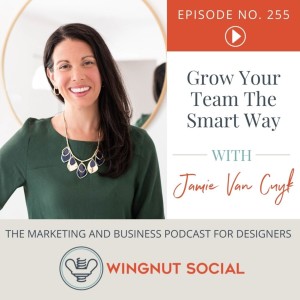
Wednesday Mar 09, 2022
Wednesday Mar 09, 2022
Is it time for you to grow your team? What are the signs it’s time to hire another team member? What process should you use to hire the best candidate for the job? Jamie Van Cuyk—the owner and lead strategist of Growing Your Team—is an expert in hiring and onboarding teams within small businesses. She shares some spectacular tips and strategies that you can implement immediately to grow your team the right way.
What You’ll Hear On This Episode of Wingnut Social
[1:05] Check out our next webinar with Stacey Martin!
[3:03] Mini News Sesh: TikTok rolling out LONG videos
[6:28] Learn more about Jamie Van Cyuk
[9:36] 4 signs it’s time to hire another team member
[13:54] Is your waitlist working for you—or against you?
[16:11] How to craft the perfect job description
[22:37] How to afford the help that you need
[27:20] Myth-busting: Should you hire for passion over skill?
[30:15] How to ensure someone is the right hire
[38:42] Jamie’s opinion on the use of personality tests
[42:27] How many candidates should you interview?
[45:50] The What Up Wingnut! Round
[49:03] How to connect with Jamie Van Cyuk
[53:40] Blooper Reel!
Connect with Jamie Van Cyuk
Growing Your Team
Friend on Facebook
Follow on Instagram
Check out her Pinterest
Connect on LinkedIn
Resources & People Mentioned
Check out our next webinar with Stacey Martin!
Stacey Martin’s Formula for Rockstar Interior Design Presentations
Turn the Ship Around! by David Marquet
Easy Render
4 signs it’s time to hire another team member
Jamie shares that there are 4 things to watch out for that are clear signs you need to grow your team. But they aren't things that are normally top of mind during your day-to-day work. So Jamie recommends that you review these signs quarterly to see if it’s time to hire:
Are you saying no to your ideal clients? If you’re saying no because your team is at capacity, it’s a problem. These people want to give you their money today. You don’t want to be losing clients that are the ideal fit for your business.
Are you losing customers due to poor customer service? Are customers pulling out of projects or backing out of contracts? If you’re not communicating and meeting their expectations throughout the process, you not only lose their business but you lose them as a referral source.
You want to do something new but you can’t. Maybe you want to start offering coaching, education, or open a retail store but you can’t because you don’t have time.
You lack skill or knowledge that is needed in your business. You can go and learn something yourself—or you can hire for that skillset. Are you the right person to learn and execute that skill? Sometimes paying the expert is worth the money because it lets you spend your time where it should be focused.
Once you’ve decided it’s time to grow your team, what are your next steps? A great hiring process.
How to craft the perfect job description (and where to post it)
Jamie believes that you shouldn’t use a templated job description when creating a job description. The job post may attract someone who can do the skill you’re hiring for but likely doesn’t speak to the right fit for your team and culture. Their style and personality have to mesh with you and your team values. So what do you do? Walk through these questions:
What is your ideal candidate?
What are their roles and responsibilities?
What does success look like in your business?
Who will you be happy to give your money to?
What’s unique about your company?
What will make someone say, “Yes, this is the place for me!” The goal of a job posting is to attract the right candidate and turn away the wrong ones. Once you develop your ideal person your job posting should speak to that person.
You can design a room that you love. But is that the right room and right design for every client? No! It might not work in their home. You may use the same concepts, materials, and create a similar flow but things will look different. A role might have similar responsibilities but will look different in each company.
Where is the best place to post a job opening? Should you hire for passion over skill? Listen to hear Jamie’s take.
How to ensure someone is the right hire
Ask questions that produce answers of value. You need to reduce the number of hypothetical questions you use, i.e. “What would you do if…?” Instead, ask questions that have them support their answers with examples: “So tell me about a time when…?” Ask them about something they will experience working for your business. Have they worked with high-end, demanding clients? How did they handle the experience? If you’re hiring someone entry-level, they may not have had those experiences in an interior design company but have had similar experiences where they have worked. They can transfer those skills to your business.
Develop a case study or opportunity for them to present their skill. If they say they know how to do CAD drawings, give them everything they need to sit down and complete a quick project. What are they able to put together? You have to know what you’re testing them on. Are you testing their ability to think through the information they’re given? Their ability to use a tool? Their thought process? You can’t test them on something that aligns with your brand because they don’t know that yet.
Move through the process quickly. Align a case study with an interview so they knock out everything immediately. But Jame is careful to note that you can’t ask too much of them before you’ve spent time with them. Don’t waste their time—and yours—if they won’t make it to the next round of interviews anyway.
What’s an easy way to weed talent out of the process (not necessarily in a good way)? Should you use personality tests in your hiring process? How many candidates should you interview? Jamie covers these questions—and so much more—in this episode!
Connect With Darla & Wingnut Social
www.WingnutSocial.com
On Facebook
On Twitter: @WingnutSocial
On Instagram: @WingnutSocial
Darla’s Interior Design Website
Check out the Wingnut Social Media Lab Facebook Group!
786-206-4331 (connect with us for your social media marketing needs)
Subscribe to The Wingnut Social Podcast on iTunes, Google Podcasts, or TuneIn
Audio Production and Show notes byPODCAST FAST TRACKhttps://www.podcastfasttrack.com

Wednesday Mar 02, 2022
Wednesday Mar 02, 2022
What is the metaverse? How will the metaverse impact the interior design industry? Is designing a virtual world the future of architecture and design as we know it? Tom Puukko joins Darla in this episode of Wingnut Social to have a conversation about virtual architecture and design. Don’t miss this futuristic conversation!
Tom is a British entrepreneur who's been working in digital innovation since 1998. He founded interiors brand Feathr.com, a marketplace where artists monetize their artworks as wallpapers and fabrics. Most recently, he's created Metaverse Interior Design, the world's first interior design marketplace for the metaverse.
What You’ll Hear On This Episode of Wingnut Social
[1:40] Upcoming webinar with Stacey Martin
[2:55] Mini News Sesh: Instagram reels from stories
[5:12] Learn more about Tom Puukko
[9:00] Learn the basics of the metaverse
[15:24] How the metaverse impacts the interior design industry
[19:16] The necessary skills to succeed in the metaverse
[24:04] Is metaverse design the design of the future?
[26:51] Where designers and architects should get started
[29:53] NFTs and Cryptocurrency in the metaverse
[33:03] The What Up Wingnut! Round
[34:17] Learn more about Tom and Metaverse Interior Design
[38:22] Blooper Reel!
Connect with Tom Puukko
Metaverse Interior Design
Feathr.com
Connect on LinkedIn
Follow on Twitter
Resources & People Mentioned
Check out our next webinar with Stacey Martin!
Stacey Martin’s Formula for Rockstar Interior Design Presentations
Good to Great by Jim Collins
Oculus Quest 2
The Sandbox
Decentraland
Horizon Worlds
Unity
Blender
So what IS the metaverse?
The metaverse consists of 3D worlds where you can interact and live a digital life. You can choose a life that’s richer, more engaging, and more entertaining than a 2D platform. You can do almost all things that you can in the real world—gamble at casinos, dance at nightclubs, visit an art gallery, build a home, etc.
Currently, you’re able to experience the metaverse through some sort of headset. We currently have proto-metaverses—the early inklings of what’s to come. If you’re in the US, you may have access to Meta’s Horizon Worlds or Decentraland. But these worlds still lack functionality and the renderings are underwhelming. But the seeds of what will come have been planted.
So how is the metaverse applicable to interior designers and architects?
Metaverse interior design: the impact on the interior design industry
Digital technology has allowed architects and interior designers to connect with customers and market themselves transactionally. But the metaverse will open up a whole new world. The metaverse is currently being built but the people building it are coders. They don’t understand how spaces and subjects interact. They don’t understand how proportions can change a building. They don’t have the knowledge architects and interior designers are trained with. Because of this, the current experience in a metaverse feels like a gimmick.
Architects and designers should be the people designing and creating the spaces. Doing so will create a whole new revenue stream. There’s no limitation of the potential volume that can be put into the space. You can sell multiple versions of different models. Designers become content creators. You can sell spaces to hundreds of thousands of people. Tom’s community—Metaverse Interior Design—will be the destination to source interior design and architect services and products.
The necessary skills to succeed in the metaverse
Luckily, metaverse interior design doesn’t necessarily rely on coding. But designers do need to have an advanced understanding of how 3D models work. If you are competent with 3D modeling and own space in a metaverse, you can move a 3D model from a computer to the metaverse. The challenge in moving between the real world and metaverse design is understanding the technical limitations of space.
Each “world” has its own set of technical specifications. Tom points out that it all boils down to low poly count (polycount is the total number of polygons found in a three-dimensional model). 3D models in the real world have a high polycount. Currently, everything in the metaverse must be simplified to a lower polycount. So you have to learn how to take a 3D model and simplify it.
Just as in real-world design, you must understand the creative vision of the client and make their vision a reality in the space you have to work with. The limitations of the real world—building codes, fire regulations, gravity, etc.—can go out the window in the metaverse. People will buy creative and conceptual ideas that can't exist in the real world. Design in the metaverse is both artwork and architecture.
Is this the design of the future? Where should designers and architects get started? Learn why you should become an early adopter of metaverse interior design in this episode!
Connect With Darla & Wingnut Social
www.WingnutSocial.com
On Facebook
On Twitter: @WingnutSocial
On Instagram: @WingnutSocial
Darla’s Interior Design Website
Check out the Wingnut Social Media Lab Facebook Group!
786-206-4331 (connect with us for your social media marketing needs)
Subscribe to The Wingnut Social Podcast on iTunes, Google Podcasts, or TuneIn
Audio Production and Show notes byPODCAST FAST TRACKhttps://www.podcastfasttrack.com

Wednesday Feb 23, 2022
Wednesday Feb 23, 2022
Do you need an interior design degree to successfully run an interior design firm? If you don’t get a formal education, where do you get an education? KD Reid is a successful interior designer with a passion for art and architecture and a reputation for crafting beautiful and functional spaces. Guess what? Zero formal design education. He shares how he grew from intern to business owner in this episode of the Wingnut Social podcast!
What You’ll Hear On This Episode of Wingnut Social
[1:24] Check out our FREE photography webinar
[2:40] Mini News Sesh: Liking stories on Instagram
[5:50] Learn all about interior designer KD Reid
[9:21] A unique way to gain interior design experience
[14:53] How KD broke out on his own
[17:51] Advice for designers without an extensive network
[19:50] How KD delegates large projects
[24:54] Where KD’s innate talent stems from
[26:52] Where will KD’s future lead?
[29:21] The What Up Wingnut! Round
[30:41] How to learn more about KD
[33:27] Blooper Reel!
Connect with KD Reid
KD Reid Interiors
Follow KD on Instagram
Resources & People Mentioned
FREE Webinar with Linda Holt on 2/24: How to Take Magazine-Worthy Smartphone Photos
Dekar Design
Mikel Welch
B Squared Harlem
Gail Doby Coaching
Parsons Yellowbrick Program
Dapper Dan: Made in Harlem: A Memoir
From Craigslist to creator
KD graduated with a degree in Sociology from Montclair State University. After graduating, he spent eight years providing mental health services in the LGBT community. Throughout his career, interior design was a hobby he enjoyed. But he never saw it as a lucrative career path. He would design spaces for friends and family.
At a time when Craigslist was popular, KD came across some design internship opportunities. He'd snag one here and there which allowed him to learn some interior design skills. Then he came across Dekar Design, a woman-led design firm focusing on hospitality and commercial projects. It was his first real look into the world of interior design. They saw that he had an eye for design and immediately let him jump on projects and learn hands-on.
KD’s journey from design assistant to principal interior designer
After working with Dekar Design, KD had the opportunity to meet Mikel Welch. One of Mikel’s first projects in NYC was a Harlem restaurant called B Squared. KD had the opportunity to work on the project which led to working with Mikel for five years. He started as a design assistant, transitioned to project manager, and became a lead designer.
Mikel gave him hands-on experience and allowed him to learn other facets of interior design. KD got to dive into set design, staging, virtual merchandising, and more. This job gave him the confidence he needed to take on projects by himself. Because of COVID, many people in KD’s network wanted to invest in building out home offices, which propelled KD to start his own business.
Where will KD’s future lead? KD wants to be clear that he is not anti-education. He simply learned that it’s not necessary to find success in the industry. But KD has goals. To reach them, he’s attending Parson’s Yellowbrick Design Program to take a product design course. One of his strengths is home decor, accessories, and styling. They’re the jewelry of a space, right? KD’s dream is to launch his own home accessory line.
What is KD’s advice for designers who don’t have an extensive network? What does his team look like? What marketing strategy does he employ? Listen to the whole episode to learn more!
Connect With Darla & Wingnut Social
www.WingnutSocial.com
On Facebook
On Twitter: @WingnutSocial
On Instagram: @WingnutSocial
Darla’s Interior Design Website
Check out the Wingnut Social Media Lab Facebook Group!
1-786-206-4331(connect with us for your social media marketing needs)
Subscribe to The Wingnut Social Podcast on iTunes, Google Podcasts, or TuneIn
Audio Production and Show notes byPODCAST FAST TRACKhttps://www.podcastfasttrack.com

Wednesday Feb 16, 2022
Wednesday Feb 16, 2022
Are you an interior designer just clamoring to work with the rich and famous? Do you want to be the designer to the stars? If you’re ready to work with affluent clients, Melissa Galt is the business coach to turn to. She loves the business of design more than design itself, which is why coaching is 95% of her business. She helps designers learn how to earn more in less time—and love their businesses a whole lot more in the process. In this episode of Wingnut Social, she shares the unique strategy she uses to attract her ideal clients (HINT: It’s all about doing what you love).
What You’ll Hear On This Episode of Wingnut Social: Interior Design Podcast
[1:23] Check out our FREE photography webinar
[3:27] Mini News Sesh: Pinterest’s augmented reality feature
[6:15] Learn more about Melissa Galt
[9:02] The top three personas of affluent clients
[17:32] The key to attracting affluent clients
[20:18] How to determine a persona’s value system
[23:55] What these clients look for when hiring a designer
[25:52] How to work smarter, not harder
[29:19] Hooking affluent clients on social media
[35:25] The What Up Wingnut! Round
[36:40] How to connect with Melissa Galt
[40:32] Blooper Reel!
Connect with Melissa Galt
Melissa’s website
Connect on LinkedIn
Follow on Instagram
Get Melissa’s book
Resources & People Mentioned
FREE Webinar with Linda Holt on 2/24: How to Take Magazine-Worthy Smartphone Photos
It's Not How Good You Are, It's How Good You Want to Be by Paul Arden
The top three personas of affluent clients
Most affluent clients aren’t obvious. In many cases, they’re the ones that are earning and saving. They are selective in where they invest their money. Melissa has nailed down five groups of avatars and nine overall personas of affluent clients based on personal experience. What are the three most common she’s come across?
The “millionaires next door.” These are the clients that are easy to educate on why next-level services are warranted. They are always learning and growing their knowledge base. They are grounded, down to earth, and make the best choices for themselves. They are the perfect clients to have because they’re loyal.
The “got rich quick.” These are the fast spenders. They’re often star athletes, musicians, startup entrepreneurs, etc. They tend to select things that are flashy and lower-quality. Melissa’s tip? Make sure they pay you upfront. Melissa has had multiple clients who were swindled out of their money.
The “Sinks and Dinks.” They are either single-income or dual-income families with no kids. Kids are a large investment, right? When you don’t have them, it makes a huge difference. Melissa’s best clients were sinks and dinks.
You select your clients as much as they select you. Melissa emphasizes that “It doesn’t matter how much money I make if I’m not proud of it.” Rich or not—choose wisely.
How to work smarter—not harder—to attract your ideal client
You need to be clear on your ICP and only work to attract those clients. The millionaires next door are low-key, private, and confidential. Marketing to them is going to be far different than the fast-spenders who are flashy in everything they do. You have to choose one persona to chase to position yourself correctly in the market.
Then you need to get clarity on where to meet and connect with your avatar. Who is already serving them that isn’t competing with you? Then you work to build your own circle of influence (or what Melissa likes to call your “Profit Posse”) and connect with these people. Co-market, co-promote, and create opportunities for introductions.
Another simple strategy? Look at your lifestyle. What do you like to do? What if you took that to the next level? If you love wine-tasting, skip the free tasting and shell out for the $250 dinner with wine pairings. You’re far more likely to rub elbows with affluent clients there. Melissa considers this “net-living” not networking. She states that “Doing what you love at a higher level will deliver the affluent clients that you most want in a very aligned and authentic way.”
How do you determine a persona’s value systems? What do affluent clients look for when hiring a designer? How do you hook them on social media? Check out the whole episode to learn more!
Connect With Darla & Wingnut Social
www.WingnutSocial.com
On Facebook
On Twitter: @WingnutSocial
On Instagram: @WingnutSocial
Darla’s Interior Design Website
Check out the Wingnut Social Media Lab Facebook Group!
1-786-206-4331 (connect with us for your social media marketing needs)
Subscribe to The Wingnut Social Podcast on iTunes, Google Podcasts, or TuneIn
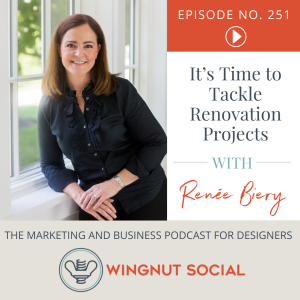
Wednesday Feb 09, 2022
Wednesday Feb 09, 2022
When Renée Biery entered the interior design industry, she thought everyone did renovations. It wasn’t until she moved back home to Delaware that she realized she—especially as a woman—was the anomaly. She had to work hard to show how much value she could add to a renovation project for both the client and the contractors. She believes that Interior designers CAN and should do more. In this episode of Wingnut Social, she shares how you can learn to master those tricky renovation projects (and the clients that come with them).
What You’ll Hear On This Episode of Wingnut Social
[1:25] Check out our FREE photography webinar
[3:30] Mini News Sesh: Scheduled live displays on Instagram
[5:10] Learn more about Renée Biery
[7:29] Why you should be an expert in project management
[15:33] Why don’t more designers take on renovation projects
[23:46] How this business model can fill your pipeline
[26:26] How Renée charges for her projects
[30:10] Market your services with social media + networking
[36:55] The What Up Wingnut round!
[38:22] How to learn more from Renée Biery
[44:35] Blooper Reel!
Connect with Renée Biery
Only Girl on the Jobsite podcast
Only Girl on the Jobsite course
Follow Renée on Instagram
Friend on Facebook
Resources & People Mentioned
FREE Webinar with Linda Holt on 2/24: How to Take Magazine-Worthy Smartphone Photos
Atomic Habits by James Clear
The Book of Boba Fett
Why you should become proficient in project management
As the owner of deVignier design, Renée has almost 30 years of experience in the industry. She’s formally trained in practical interior architecture with advanced technical and rendering proficiency. She sought to be a one-stop-shop that offers everything from project management and design to decorating. She loves being part of the design and build. It also sets her apart from other women in the industry.
Despite her formal education, Renée believes that it isn’t necessary nor should it be a barrier to entry. She learned more from the women she’s worked with over the years. You simply learn as you go. You can find contractors, architects, etc. who will work with you to get a permit or draw a design.
Renée believes that offering renovation projects will sustain the industry. Why? Because procurement is becoming a problem. Many firms are giving up that revenue stream. But what does that leave them? There are only so many billable hours in design. If you’re trying to salvage your billable hours, managing renovation projects is a great way to get started.
Why don’t more designers take on renovations?
Renée believes that many designers lack confidence in their skills. Plus, it can be intimidating. Everyone watches HGTV and every episode of any show features some great challenge to overcome. Those challenges get expensive. That’s why Renée encourages people to gain experience in numerous ways. She started “The Only Girl on the Jobsite” because as the only woman among 20 guys on a worksite, you feel like the odd man out. So you have to build skills to level the playing field.
Where do you get your feet wet? Do you intern under someone with the experience necessary? Some people have renovated their own spaces and feel comfortable learning as they go. Plus, if you have some experience, you can build on it. Price yourself at an obtainable level until you’ve built a portfolio. There will be clients that are excited about getting a great price and don’t mind that you’re learning. But above all, do not fake it til you make it or you’ll end up making expensive mistakes.
Taking on renovation projects sets you apart and gives you a leg up. What else can you do to break the mold? If you decide to add renovations and project management to your portfolio, how do you market yourself? Renée shares a plethora of advice in episode #251—don’t miss it!
Connect With Darla & Wingnut Social
www.WingnutSocial.com
On Facebook
On Twitter: @WingnutSocial
On Instagram: @WingnutSocial
Darla’s Interior Design Website
Check out the Wingnut Social Media Lab Facebook Group!
1-786-206-4331 connect with us for your social media marketing needs)
Subscribe to The Wingnut Social Podcast on iTunes, Google Podcasts, or TuneIn
Audio Production and Show notes byPODCAST FAST TRACKhttps://www.podcastfasttrack.com
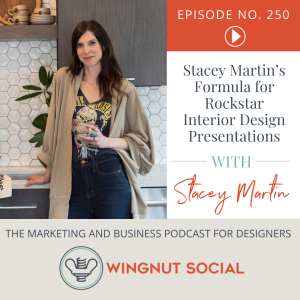
Wednesday Feb 02, 2022
Wednesday Feb 02, 2022
Interior design presentations are not easy to knock out of the park. If you’ve spent hours on a presentation only to receive a lackluster response from a client, you’re not alone. Stacey Martin has a mind-boggling 95% approval rating—without revisions—on her presentations. What’s the secret to her success? She shares the mind-blowing systems and processes she uses in this episode of the Wingnut Social podcast!
What You’ll Hear On This Episode of Wingnut Social
[2:07] Check out our FREE photography webinar
[3:15] Mini News Sesh: Subscriptions on Instagram
[7:22] Learn more about Stacey Martin
[12:02] Stacey’s interior design presentation
[20:44] Brand storytelling is the key
[26:06] Feeling out a client’s budget
[30:42] 3 pitfalls to avoid in your presentations
[34:53] The What Up Wingnut Round!
[40:38] Blooper Reel!
Connect with Stacey Martin
Follow Stacey on Instagram
Stacey’s design business: The Freshmaker
Resources & People Mentioned
FREE Webinar with Linda Holt on 2/24: How to Take Magazine-Worthy Smartphone Photos
BOOK: The Legacy of Luna
BOOK: How to Win Friends and Influence People
Nikki Amodio
Take your potential clients on a journey
Before Stacey became an interior designer, she was in trend forecasting and design for sports brands. The higher-ups were notorious for being naysayers—many designers didn’t get their designs approved. But Stacey soon realized that the blame wasn’t always on the management. The designers didn’t know how to present their ideas in a manner that would get them a “yes.”
So Stacey took note. When it was her turn to present, she started with the “why.” She started her presentation focusing on the brand’s pain points before she shifted to the goals of the line. By the time she got to her ideas and solutions, the VP had already been agreeing with everything she said. She took him on a journey.
She sold him on why her idea was the solution to their problems. He knew how it would lead them to make them more money. When Stacey transitioned to interior design, she used this same process with her clients.
It’s about the design AND the client
In addition to hearing someone’s design woes, Stacey asks questions that are NOT related to design. She wants to learn who they are.
What music do they like? Favorite song? Favorite band?
Where do they like to travel? What are their favorite trips? Where do they want to visit?
What do they do for fun? Do they like to cook? Is yoga their jam?
Do they have kids or pets?
These things help Stacey build a visual story and build an aesthetic direction. She distills what she’s learned down to three images that define the direction they’ll take. So when they get to the design presentation, she knows who they are and what problems they want to solve.
How to nail your interior design presentation
She labels their project with three keywords that hone in on the goal for the design. It might be modern, timeless, and family-friendly. This sets the tone for the presentation. She iterates the problem they’re looking to solve (i.e. lack of storage space) and shares her solution.
Stacey may include a “tortoise-shell side table” as a nod to this person’s trip to Aruba where they swam with sea turtles. As she explains the choices she made, she talks specifically about how each element reflects and solves their problem(s). The details tie back to their memories and things that make them happy. It’s creating a story about who they are and how the room reflects their personality.
The more you can show your client the “why” of your selections and how you’re making choices based on who they are, the more they feel understood. That leads to trust. Every piece is a thoughtful choice based on who they are. As a designer, Stacey emphasizes that “You’re using your talents and your skillset to curate those choices to create an immersive environment that really feels like who they are.”
What are three pitfalls you should avoid in your presentations? Listen to the whole episode for more of Stacey’s strategy.
Connect With Darla & Wingnut Social
www.WingnutSocial.com
On Facebook
On Twitter: @WingnutSocial
On Instagram: @WingnutSocial
Darla’s Interior Design Website
Check out the Wingnut Social Media Lab Facebook Group!
1-786-206-4331 (connect with us for your social media marketing needs)
Subscribe to The Wingnut Social Podcast on iTunes, Google Podcasts, or TuneIn
Audio Production and Show notes byPODCAST FAST TRACKhttps://www.podcastfasttrack.com
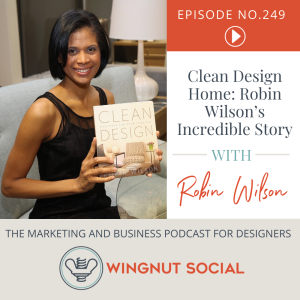
Wednesday Jan 26, 2022
Wednesday Jan 26, 2022
Robin Wilson grew up in Austin, TX with awful asthma and allergies. Her parents found a holistic pediatrician that said, “You can raise a strong child or you can raise a child on strong medicine.” So she started swimming, biking, walking, track, etc. to strengthen her lungs instead of taking strong medication. Because of her background, she became an advocate for clean construction. Any number of things on a site can lead to an asthmatic episode. So she dove deep into hypoallergenic design.
Now, Robin Wilson is a U.S. lifestyle brand, author, designer and real estate developer. Named to the Inc. magazine Female Founders 100 List in 2020, she is a world-class thought leader on hypoallergenic, sustainable and eco-conscious options for the B2B and B2C marketplace. She is a two time #1 Amazon bestselling author and has been featured on multiple news segments as an expert on eco-friendly design and allergy-focused segments.
What You’ll Hear On This Episode of Wingnut Social
[4:29] Mini News Sesh: Vertical Stories on Instagram
[6:40] Designer Robin Wilson’s origin story
[14:21] Robin’s thoughts on design school
[22:20] From project management to Clean Design Home
[33:42] Robin’s marketing process
[36:47] Clean Design Home x Martex
[47:57] How Robin’s marketing focus has shifted
[54:38] The What Up Wingnut! Round
[56:50] How to connect with Robin Wilson
[58:45] Blooper Reel!
Connect with Robin Wilson
See an overview of Robin’s company at https://ablueegg.com/
Robin’s Book: Clean Design: Wellness for your Lifestyle
Clean Design Home x Martex
Follow Robin Wilson Home on Instagram
Resources & People Mentioned
Photography webinar coming up Feb. 24th!
Wingnut Social Episode #12 with Linda Holt
The Dream Giver by Bruce Wilkinson
Resource Furniture
Robin’s story: following her passion
Robin had a wonderful mentor/sponsor that helped her navigate her future. He asked her, “What would you do if you knew you could not fail?” followed by, “What is your passion?” Her answer was real estate. So he taught her how real estate worked and how to build wealth. She went on to get her Master’s in Real Estate Finance. She was one of three women in the graduate program.
One of her professors told her that she wasn’t going to have an easy road because she was a black woman in a man’s world. Instead of being offended, she decided to listen to him. He advised her to figure out something she could do immediately to make her degree worth something. He recommended she become a project manager—the busy homeowners’ best friend. She made $1.2 million in her first year in project management.
From project management to Clean Design Home
Part of Robin’s design signature started because she worked on tiny New York apartments that had doors everywhere. So she started implementing pocket doors in her design. On one particular project, she bought a Murphy bed that looked like a desk. She found a table that expanded to fit six people. She treated this client like royalty, not realizing she had connections in the industry.
After this project, Robin got a phone call from Adam Glassman, the creative director for Oprah. She didn’t return his phone calls because she thought she was being pranked. He called three times before she realized it was the real deal, so she called him back. One project changed the trajectory of her future career.
Robin firmly believes, “If you do great work, people will tell four people. If you do poor work and you’re nasty, mean, and rude—they will tell 20 people at a dinner party…If you do great work they will tell someone that’s a likely customer in the future.”
Clean Design Home
Clean Design Home came about when Robin wrote her book, “Clean Design: Wellness for your Lifestyle.” It became a #1 best-seller on Amazon. Clean design is everything she does. She puts clean products in people’s homes. She supports hypoallergenic lifestyles.
Robin had a legacy brand, Robin Wilson Home. But she saw a shift in consumer spending from paying for quality to paying for cheaper products on Amazon. She felt her brand was gone and she was close to quitting. But Robin ended up being featured in articles about the top 10 black businesses to support.
She changed to a generic name (Clean Design Home) to speak to her niche. She dug deep into the hypoallergenic space and created luxury products. She found a licensing partner and saw a 3,000% sales increase after the New York Magazine article. She made $80,000 in 30 days. Then she was signed by West Point Home (Martex) and they created “Clean Design X Martex.” In 2020, she was ready to quit. Now she has a global brand in Macy’s.
What does Robin believe was the secret to her success? How has Robin’s marketing focus shifted since she launched her businesses? What tips does she share to help your business grow? Listen to the whole episode to hear more of her awe-inspiring journey.
Connect With Darla & Wingnut Social
www.WingnutSocial.com
On Facebook
On Twitter: @WingnutSocial
On Instagram: @WingnutSocial
Darla’s Interior Design Website
Check out the Wingnut Social Media Lab Facebook Group!
1-786-206-4331 (connect with us for your social media marketing needs)
Subscribe to The Wingnut Social Podcast on iTunes, Google Podcasts, or TuneIn
Audio Production and Show notes byPODCAST FAST TRACKhttps://www.podcastfasttrack.com



